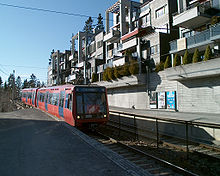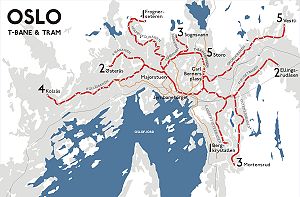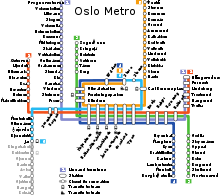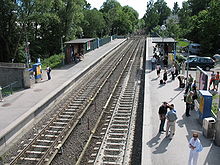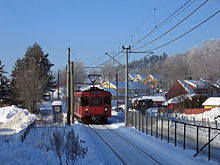- Oslo Metro
-
Oslo Metro 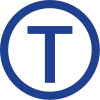
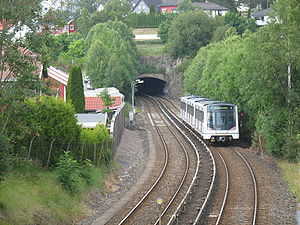
Info Owner Ruter Locale Oslo, Norway Transit type Rapid transit Number of lines 6 Number of stations 94 (August 2011) Daily ridership 268,000 (2009)[1] Operation Began operation 31 May 1898 as suburban tram
22 May 1966 as T-baneOperator(s) Oslo T-banedrift Number of vehicles 83 (MX3000) Technical Track gauge 1,435 mm (4 ft 8 1⁄2 in) Electrification third rail, 750 V DC The Oslo Metro (Norwegian: Oslo T-bane or Oslo Tunnelbane) is the rapid transit system of Oslo, Norway, operated by Oslo T-banedrift on contract from the transit authority Ruter. The network consists of six lines that all run through the city centre, with a total length of 84.2 kilometres (52.3 mi). It has a daily ridership of 268,000 (2009)[1] with 105 stations of which 16 are underground or indoors. In addition to serving all 15 boroughs of Oslo, two lines run to Bærum.
The first rapid transit line was the Holmenkoll Line, opened in 1898, with the branch Røa Line opening in 1912. It became the first Nordic underground railway in 1928 when the underground line to Nationaltheatret was opened. The Sognsvann Line opened in 1934 and the Kolsås Line in 1942. The opening of the upgraded T-bane system on the east side of town occurred in 1966, after the conversion of the 1957 Østensjø Line, followed by the new Lambertseter Line, the Grorud Line and the Furuset Line; in 1993 trains ran under the city between the two networks in the Common Tunnel, followed by the 2006 opening of the Ring Line.
All the trains are operated with MX3000 stock. These replaced the older T1000 stock between 2006 and 2010.
Contents
History
Main article: History of the Oslo Tramway and Metro Holmenkoll Line tram at Nationaltheatret in 1928
Holmenkoll Line tram at Nationaltheatret in 1928
Suburban lines in the west
Rail transport in Oslo started in 1854, with the opening of Hoved Line to Eidsvoll, through Groruddalen. In 1872, Drammen Line, going through Oslo West, and in 1879, Østfold Line going through Nordstrand opened, offering a limited rail service to those parts of the city.[2] By 1875, Kristiania Sporveisselskab (KSS) opened the first horsecar trams.[3] In 1894 electric trams were in service by Kristiania Elektriske Sporvei (KES).[4]
The first suburban tram line was the Holmenkoll Line that was opened by Holmenkolbanen in 1898; like all the later suburban tram line these were electric trams with a grade-separated right-of-way and proper stations instead of tram stops, making it the first rapid transit in Oslo. Unlike the other suburban tram lines that were built later, the Holmenkollen Line was not extended into the city as a streetcar—instead passengers had to change at Majorstuen to the streetcars, though the system did not take into use wider suburban stock (3.1 metres (10 ft)) until 1909.[5] A branch line was opened in 1912, to Smestad,[6] and in 1916 the Holmenkollen Line was extended to Tryvann, with the last part from Frognerseteren single track and used for freight,[7] and removed in 1939.[8]
In 1912, the construction of the first underground railway in the Nordic Countries started, when A/S Holmenkolbanen started construction of an extension of their line from Majorstuen to Nationaltheatret; the 2.0 kilometres (1.2 mi) line was opened in 1928, with one intermediate station at Valkyrie Plass, giving the two suburban lines access to the central business district of Oslo.[9]
The success of the suburban lines tempted KES to extend their streetcar service west from Skøyen as a suburban line; the Lilleaker Line opened to Lilleaker in 1919, to Avløs in 1924 and to Kolsås in 1930. A new section from Jar to Sørbyhaugen opened in 1942, connecting the line from Jar to Kolsås to Nationaltheatret, and making it a rapid transit and the replacement of stock with wide suburban standard.[10][11] This service remained part of the municipal Oslo Sporveier, that had bough all the streetcar companies in 1924.[12]
Compensation for large amounts of damage to houses along the route during construction, along with higher construction costs than calculated was a heavy burden on the company, and in 1934, the municipality of Aker took over the common stock, though the preferred stock remained listed on the Oslo Stock Exchange until 1975, as Oslo Sporveier gradually took over the operation of the western suburban lines. Akersbanerne opened the connecting Sognsvann Line in 1934.[9]
Metro
The first idea to launch a city-wide rapid transit was launched in 1912 with the construction of the Ekeberg Line; constructed with the same width profile as the Holmenkollen Line, the plan was to build a tunnel under the city center and run through trains, but large cost expenditures on the first section of the Common Tunnel ceased the plans. As part of the rebuilding after World War II a planning office for a T-bane was established in 1949, with the first plans launched in 1951; in 1954, the city council decided to build the T-bane network in Eastern Oslo with four branches. The system would feature improvements over the suburban lines in having a third rail power supply, cab signaling with Automatic Train Protection, stations long enough for six-car trains and level crossings replaced by bridges and underpasses—specifications christened metro standard.[13]
At the time there were two suburban tramways on the east side, the Ekeberg Line (opened in 1919)[4] and the Østensjø Line (1923).[14] Only the latter would be connected to the T-bane; the Ekeberg Line would remain a tramway, but three new lines were to be built—the Grorud Line on the north side and the Furuset Line on the south side of Groruddalen and the Lambertseter Line on the east of Nordstrand. These areas were all chosen as new suburbs for Oslo, and would quickly need a good public transport system; suburban lines would first be built out extending from the existing tramway, and later a final section with tunnel to the central station would be built. The Lambertseter Line was opened in 1957, from Brynseng to Bergkrystallen while the Østensjø Line was extended to Bøler in 1958.[13]
The metro opened on 22 May 1966, when the Common Tunnel opened from Brynseng to the new downtown station of Jernbanetorget, located beside the Oslo East Railway Station. In October the Grorud Line opened to Grorud while the Østensjø Line was connected to the system in 1967 when the line also was extended to Skullerud. In 1970, the Furuset Line opened to Haugerud and extended to Trosterud in 1974, at the same time as the Grorud Line was extended to Vestli. By 1981, the Furuset Line had reached Ellingsrudåsen.[15] The metro took delivery of T1000 rolling stock from Strømmens Værksted; from 1964 to 1978, 162 cars in three-car configurations were delivered for the eastern network.
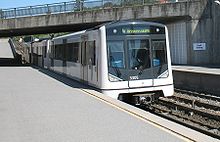 Delivery of the MX3000 stock started in 2006.
Delivery of the MX3000 stock started in 2006.
One tunnel
Main article: Common TunnelThe eastern network was extended from Jernbanetorget to Sentrum in 1977, but Sentrum station had to close in 1983, due to water leakages. When it opened again in 1987, the west network tunnel had also been extended to the station, that opened as Stortinget. Through services were not possible at the time because of incompatible signaling- and power equipment. Not until 1993 did the first trains run through the station, after the Sognsvann Line had been rebuilt to "metro standard"; the Røa Line followed in 1995.[16] The Holmenkoll Line and Kolsås Line remained without this standard, using dual mode trains that switch to overhead lines at Frøen and Montebello.[17] The western network took delivery of 33 T1300 cars in 1978–81, with an additional 16 converted from T1000. In 1994 twelve T2000 cars were delivered for the Holmenkollen Line.[18]
In 2003, the Ring Line opened from Ullevål stadion to Storo.[11] The following year construction caused a tunnel to collapse on the Grorud Line—the system's busiest—forcing a shutdown of this line until December and creating a havoc of overfilled replacement buses.[19] The ring was completed in 2006 onwards to Carl Berners plass.[11] At the same time the Kolsås Line was closed for upgrade to metro standard.[11] In 2003, the section of the Kolsås Line in Bærum closed due to budget disagreements between the two counties; after a year of unpopular replacement buses, the line was reopened, only to be closed again in 2006 for upgrade to metro standard. Disagreements between the two counties means the upgrade will be done separately on the two sides of the municipal boundary, with the Oslo side opening first.[20] In 2006, the system started taking delivery of the new MX3000 units that will replace the old stock.[21] The history of the metro and public transport in Oslo has been preserved at the Oslo Tramway Museum located at Majorstuen.[22]
Network
Line # Termini Lines Stations 1 Frogneseteren ↔ Helsfyr (↔ Ellingsrudåsen) Holmenkollen Line, Furuset Line 34 2 Østerås ↔ Ellingsrudåsen Røa Line, Furuset Line 26 3 Sognsvann ↔ Mortensrud Sognsvann Line, Østensjø Line 27 4 Ring ↔ Bergkrystallen Ring Line, Lambertseter Line 22 5 Storo ↔ Vestli Ring Line, Grorud Line 26 6 Bekkestua ↔ Ring Kolsås Line, Ring Line 12 The Oslo Metro operates to all fifteen boroughs of Oslo, plus into the neighboring municipality of Bærum. There are six lines, numbered 1 through 6, each color coded. All go through the Common Tunnel, serving eight branch lines. In addition three lines operate to the Ring Line. The only branch to have two lines is the Furuset Line, served by both 1 and 2.[23]
The Grorud and Furuset Line head northeast into Groruddalen, while the other two eastern branches head south into Nordstrand. On the west side, the Holmenkoll and Sognsvann Line cover the northern boroughs of Oslo, along with the Ring Line that connects the northeastern and northwestern parts of town. The Kolsås and Røa Line reach deep into the neighbouring municipality of Bærum.[11] The system has six routes, 1 to 6, that all run through the Common Tunnel before reaching out to different lines, or into the Ring. Each line runs every 15 minutes, 30 minutes in the late evening and in the morning at weekends. Trains run from about 0500 (0600 at weekends) to 0100 the next morning. In addition, the east side of line 5 has an enhanced service weekdays between 0700 and 1900 giving a 7.5 minute schedule on that route.[23]
Intermodality
Main article: RuterThe metro is integrated into the public transport system of Oslo and Akershus through the agency Ruter, allowing tickets to also be valid on the Oslo Tramway, city buses, ferries, and the Oslo Commuter Rail operated by Norges Statsbaner.[24] A new, wireless ticketing system, Flexus, has in the recent years been implemented.[25] From 2 October 2011 a single ticket for one zone (the entire metro system is in zone 1) cost NOK 28, monthly passes NOK 590.[26] This includes all means of public transport within the zone you've got a ticket for (for the metro, zone 1).There is a fine of NOK 750, or NOK 900, for not having a valid ticket.[27]
Oslo maintains a street tram system with six lines, of which two are suburban lines.[28] The street trams operate mostly within the borders of the Ring Line, providing a frequent service in the city center, with lower average speeds but with more stops. There are major transfer points to the tramway at Majorstuen, Jernbanetorget, Jar, Storo and Forskningsparken.[29]
The commuter train serves suburbs further away from Oslo, though some of the commuter rail services remind of a rapid transit service, in particular line 400 and line 500, to Lillestrøm, Asker and Ski, with higher service frequency through the continual populated area of Oslo. Transfer to railway services is available at Jernbanetorget (to Oslo S) and Nationaltheatret, the latter with a considerably shorter walk.[30]
Bus services are provided to numerous stations. Most bus services provide feeding to the metro system where possible, and then do not continue in to town. However, since the metro operates solely into town, instead of across it, many buses operate between stations on different lines, or provide alternative routes across town.[31]
Rolling stock
Main article: Oslo Metro rolling stockAfter the conversion to metro a number of versions of the T1000 stock have been delivered. This includes 146 cars of the types T1 through T4, that have third-rail only operation, and thus do not run on the Holmenkoll and Kolsås Line. These run usually in units of three or six (sometimes four or five) cars on lines 2. Types T5 to T8, 49 in total, delivered with both third-rail and overhead wire equipment, normally run on line 1 (two cars) and 4/6 (three cars).[18]
When the Holmenkoll Line was connected to the T-bane it was still using old teak cars; to allow through services the T2000, capable of dual-system running, was delivered in 1993. They have not been particularly successful and only 12 units were delivered, operating in pairs on line 1.[32]
The latest delivery is the MX3000, set to replace the oldest T1000 stock. Delivery started in 2006, and unlike older stock the MX3000 units are painted white instead of red. 83 three-car units were ordered in 2006;[21] a further 32 were ordered in December 2010.[33]
Stations
 Nydalen on the Ring Line opened in 2003 is an underground station on the western network.
Nydalen on the Ring Line opened in 2003 is an underground station on the western network. Main article: List of Oslo T-bane stations
Main article: List of Oslo T-bane stationsThe system consists of 104 stations, of which 16 are underground or indoors.[34][35][36][37] The only underground station on the pre-metro western network was Nationaltheatret, and most of the underground station are in the common tunnel under the city center, or in shorter tunnel sections on the eastern network; in particular the Furuset Line runs mainly underground, with all but Haugerud built in or at the opening of a tunnel.[38]
Stations in the city center are located close to large employment centers as well as connection possibilities to other modes of transport, such as tram, rail and bus. All stations can be identified at ground level by signs with a blue T in a circle. Stations outside the center are unmanned since the 1995, with ticket machines for fare purchase;[11] some stations feature kiosks. A system of turnstiles have been installed, but will not be activated until the Flexus ticket is taken into use. All stations have step-free accessibility through at least one entrance (except the inbound platform at Frøen), and the platform height is aligned with the train cars.[39]
Line 1 (purple)
Line 1: Frognerseteren – Stortinget – Helsfyr (– Ellingsrudåsen) Frognerseteren • Voksenåsen • Lillevann • Skogen • Voksenlia • Holmenkollen • Besserud • Midtstuen • Skådalen • Vettakollen • Gulleråsen • Gråkammen • Slemdal • Ris • Gaustad • Vinderen • Steinerud • Frøen • Majorstuen • Nationaltheatret • • Stortinget • Jernbanetorget • Grønland • Tøyen • Ensjø • Helsfyr • (Brynseng • Hellerud • Tveita • Haugerud • Trosterud • Lindeberg • Furuset • Ellingsrudåsen)
Line 2 (orange)
Line 2: Østerås – Smestad – Stortinget – Ellingsrudåsen Østerås • Lijordet • Eiksmarka • Ekraveien • Røa • Hovseter • Holmen • Makrellbakken • Smestad • Borgen • Majorstuen • Nationaltheatret • Stortinget • Jernbanetorget • Grønland • Tøyen • Ensjø • Helsfyr • (Brynseng • Hellerud • Tveita • Haugerud • Trosterud • Lindeberg • Furuset • Ellingsrudåsen)
Line 3 (green)
Line 3: Sognsvann – Ullevål – Stortinget – Mortensrud Songsvann • Kringsjå • Holstein • Østhorn • Tåsen • Berg • Ullevål stadion • Forskningsparken • Blindern • Majorstuen • Nationaltheatret • Stortinget • Jernbanetorget • Grønland • Tøyen • Ensjø • Helsfyr • Brynseng • Hellerud • Godlia • Skøyenåsen • Oppsal • Ulsrud • Bøler • Bogerud • Skullerud • Mortensrud
Line 4 (dark blue)
Line 4: Bergkrystallen – Stortinget – Ullevål stadion From line 6 • Ullevål stadion • Forskningsparken • Blindern • Majorstuen • Nationaltheatret • Stortinget • Jernbanetorget • Grønland • Tøyen • Ensjø • Helsfyr • Brynseng • Høyenhall • Manglerud • Ryen • Brattlikollen • Karlsrud • Lambertseter • Munkelia • Bergkrystallen
Line 4 and 6 serve the Ring Line, continuing in a loop once they leave the Common Tunnel.Line 5 (yellow)
Line 5: Storo – Ullevål – Stortinget – Grorud – Vestli Storo • Nydalen • Ullevål stadion • Forskningsparken • Blindern • Majorstuen • Nationaltheatret • Stortinget • Jernbanetorget • Grønland • Tøyen • Carl Berners plass • Hasle • Økern • Risløkka • Vollebekk • Linderud • Veitvet • Rødtvet • Kalbakken • Ammerud • Grorud • Romsås • Rommen • Stovner • Vestli
Line 6 (light blue)
Line 6: Nydalen – Carl Berners plass – Stortinget – Smestad – Kolsås Kolsås • Hauger • Gjettum • Valler • Avløs • Haslum • Gjønnes • Bekkestua • Ringstabekk • Jar • Bjørnsletta • Åsjordet • Ullernåsen • Montebello • Smestad • Borgen • Majorstuen • Nationaltheatret • Stortinget • Jernbanetorget • Grønland • Tøyen • Carl Berners plass • Sinsen • Storo • Nydalen • becomes line 4
Line 4 and 6 serve the Ring Line, continuing in a loop once they leave the Common Tunnel.
Note: As of August 2006, the line to Kolsås is closed for maintenance. The temporary western terminus since December 2010 for line 6 is Jar.
Future expansion
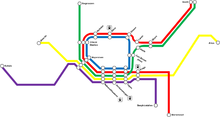 The proposed T-bane structure after Oslopakke 3
The proposed T-bane structure after Oslopakke 3 Main article: Oslo Package 3
Main article: Oslo Package 3- Between 2006 and 2014 the Kolsås Line is being upgraded to metro standard.[40]
- As part of the political compromise Oslo Package 3 a number of changes have been proposed for the Oslo Metro.[41]
- Expansion of the Furuset Line to Lørenskog with stations at Skårer, Lørenskog Centre and a new terminus at Akershus University Hospital, with travel time to Jernbanetorget of 27 minutes.
- The frequency on the eastern lines will be increased. Grorudbanen, Lambertseterbanen and Furusetbanen will get eight departures per hour, with half (B-routes) terminating at Majorstuen for Lambertseterbanen and Furusetbanen. This will reduce the capacity in the Common Tunnel.
- Because of this it has been suggested that Holmenkollbanen be converted to a tramway connecting to the Ullevål Hageby Line, since it already uses overhead wires. While this was part of Oslo Package 3, the city council has since initialized retaining it as a metro line, but converting it to third-rail operation. This would allow the use of the new MX-stock in time for the FIS Nordic World Ski Championships 2011.[42]
- The construction of the Løren Line will connect the Ring Line with the Grorud Line, allowing trains to run from Grorudbanen directly to the Ring. In addition a new station at Løren would be built. This will not increase the load on the Common Tunnel since it is an extension of the current line that terminates at Storo. This will give all stations[where?] except Hasle and Løren eight departures per hour.
- A new station, Homansbyen, on the Common Tunnel between Majorstuen and National Theatre.
See also
Notes
- ^ a b Ruter. "Ruterrapport 2009:10" (in Norwegian). http://ruter.no/Global/dokumenter/dokumentvedlegg/K2010web.pdf. Retrieved 2009-10-09.
- ^ Bjerke and Holom, 2004: 9
- ^ Aspenberg, 1994: 6
- ^ a b Aspenberg, 1994: 7
- ^ Aspenberg, 1994: 8
- ^ Aspenberg, 1994: 12
- ^ Aspenberg, 1994: 14
- ^ Bjerke and Holom, 2004: 347
- ^ a b Aspenberg, 1994: 17
- ^ Bjerke and Holom, 2004: 346
- ^ a b c d e f Oslo T-banedrift. "Kort historikk" (in Norwegian). http://www.tbane.no/index.aspx?cat=615223&id=745387&mid=745387. Retrieved 2008-06-09.
- ^ Aspenberg, 1994: 19
- ^ a b Aspenberg, 1994: 29
- ^ Aspenberg, 1994: 16
- ^ Aspenberg, 1994: 29–30
- ^ Aspenberg, 1994: 30
- ^ Oslo Sporveier. "Milepæler 1875–2005". Archived from the original on 2008-04-29. http://web.archive.org/web/20080429042349/http://www.sporveien.no/Kultur-og-historie-/153/. Retrieved 2008-06-09.
- ^ a b Aspenberg, 1994: 62
- ^ Akers Avis Groruddalen (2004-07-28). "Full stopp for Grorudbanen". http://www.groruddalen.no/full-stopp-for-grorudbanen.174300-77747.html.
- ^ Oslo T-banedrift. "Kolsåsbanen i mai" (in Norwegian). http://www.tbane.no/index.aspx?cat=617538&id=917829. Retrieved 2008-06-09.
- ^ a b Oslo T-banedrift (2006). "Nye T-banevoger i prøvedrift" (in Norwegian). http://www.tbane.no/userfiles/T-bane-folder_med_sprreunderskelse_vol.1.pdf.
- ^ Local Transport Historical Association. "Short about LTF". http://www.sporveismuseet.no/ltf/index_uk.html. Retrieved 2008-08-21.
- ^ a b Ruter (2008). "Rutetider" (in Norwegian). http://trafikanten.no/Gallery/1-GalleryRot/24-Rutetabeller/25-2010/26-Oslo/T-banen%20h101.pdf. Retrieved 2010-11-10.
- ^ Ruter. "Transportmidlene" (in Norwegian). Archived from the original on 2008-04-28. http://web.archive.org/web/20080428002536/http://www.ruter.no/Reiseinformasjon/Transportmidlene/. Retrieved 2008-08-07.
- ^ Ruter. "Hva er Flexus" (in Norwegian). Archived from the original on 2008-04-27. http://web.archive.org/web/20080427013238/http://www.ruter.no/Billetter-og-priser/Hva-er-Flexus/. Retrieved 2008-08-07.
- ^ Ruter. "Priser og billetter" (in Norwegian/English). http://www.ruter.no/Global/Bilder/Sonekart/NYPS_soner_og_priser.pdf. Retrieved 2011-10-20.
- ^ Ruter. "Billettkontroll: Hva koster god samvittighet?" (in Norwegian). http://www.ruter.no/din-reise/billettkontroll/. Retrieved 2011-10-20.
- ^ Bjørn and Holum, 2004: 344
- ^ Oslo Sporvognsdrift (2007). "Trikken 2007". http://ruter.no/Global/PDF_filer/linjekart/Trikken2007-12webOS.pdf. Retrieved 2008-08-07.
- ^ Ruter (2007). "Skinne 2007". http://ruter.no/Global/PDF_filer/linjekart/Skinne2007-10Web.pdf. Retrieved 2008-08-07.
- ^ Ruter (2007). "Buss Alle 2007". http://ruter.no/Global/PDF_filer/linjekart/BussAlle2007-10Web.pdf. Retrieved 2008-08-07.
- ^ Oslo T-banedrift. "T-2000" (in Norwegian). http://www.tbane.no/userfiles/T-2000.doc. Retrieved 2008-06-09.
- ^ "Railway Gazette: Oslo orders more metro cars". 2010-12-24. http://www.railwaygazette.com/nc/news/single-view/view/oslo-orders-more-metro-cars.html. Retrieved 2010-12-24.
- ^ Oslo T-banedrift (2008). "Linjekart". http://www.tbane.no/userfiles%5CLinjekart.pdf.
- ^ Oslo Sporveier. "T-banestasjonene i Øst" (in Norwegian). Archived from the original on 2008-03-08. http://web.archive.org/web/20080308085851/http://www.sporveien.no/Kultur-og-historie-/148/766/. Retrieved 2008-06-09.
- ^ Oslo Sporveier. "T-banestasjonene i Vest" (in Norwegian). Archived from the original on 2008-04-01. http://web.archive.org/web/20080401132522/http://www.sporveien.no/Kultur-og-historie-/148/T-banestasjonene-i-vest/. Retrieved 2008-06-09.
- ^ Oslo Sporveier. "Holmenkollbanens stasjoner" (in Norwegian). Archived from the original on 2008-04-01. http://web.archive.org/web/20080401131606/http://www.sporveien.no/Kultur-og-historie-/148/1019/. Retrieved 2008-06-09.
- ^ Aspenberg, 1994: 33
- ^ Ruter. "Tilgjengelighet for alle" (in Norwegian). http://ruter.no/Reiseinformasjon/Tilgjengelighet-for-alle/. Retrieved 2008-08-21.
- ^ Ruter. "Husebybakken stasjon nedlegges" (in Norwegian). Archived from the original on 2008-08-01. http://web.archive.org/web/20080801084354/http://ruter.no/Presse/Pressemelding/Husebybakken-stasjon-nedlegges/. Retrieved 2008-08-13.
- ^ Akershus County Municipality (2006-05-29). "Oslopakke 3" (in Norwegian). http://www.akershus.no/file.php?id=4761.
- ^ Ullern Avis Akersposten (2008-04-29). "Holmenkollbanen får full T-banestandard" (in Norwegian). http://www.akersposten.no/nyheter/holmenkollbanen-far-full-t-banestandard-1.4766032.
References
- Aspenberg, Nils Carl (1994). Trikker og forstadsbaner i Oslo. Oslo: Baneforlaget. ISBN 82-91448-03-5.
- Bjerke, Thor and Holom, Finn (2004). Banedata 2004. Oslo / Hamar: Norsk Jernbaneklubb / Norsk Jernbanemuseum. ISBN 82-90286-28-7.
External links
- T-bane map
- Oslo T-bane at UrbanRail.Net
- Oslo T-banedrift
- Ruter
- Trafikanten (fare and timetable information)
Urban public transport networks and systems in Norway Commuter rail 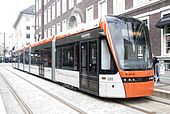
Rapid transit Oslo MetroTram Trolleybus BergenFunicular Categories:- Oslo Metro
- Underground rapid transit in Norway
- Rapid transit in Norway
- 1966 establishments in Norway
Wikimedia Foundation. 2010.

